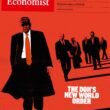Forty years after it first launched magazines in New York, Bauer Media Group, of Germany, is exiting the US market. It is selling a business which in 2020 had revenue of $80m (15% down on the previous year). Little more than a decade ago, the US company (which currently employs some 110 people) had revenue of more than $450m – 15% of the whole group.
A360 Media, owned by Atlanta based Accelerate 360 (formerly known as American Media Inc) is buying Bauer’s remaining US business including Woman’s World, First for Women and 100 special interest titles including bookazines – four years after it acquired the company’s celebrity and teenage magazines which had accounted for two-thirds of Bauer’s US business.
A360 publishes some of the leading celebrity and health & fitness media brands in the US, including: Us Weekly, Men’s Journal, and InTouch. Prior to this latest acquisition, its portfolio has claimed a combined total circulation of 5.3m, reaching 32.6m men and women each month. The Atlanta-based company’s digital properties have 50m monthly uniques.
For Bauer – which once claimed to be the world’s largest magazines group – the US exit is the last dramatic retreat from non-European markets after 40 years of seemingly uninhibited global expansion.
It was in 1981 that – at the regulatory limit of its ability to expand much further in Germany – Bauer set out to conquer the world. It chose to start in the United States.
The New York media establishment were sniffy about Bauer’s decision to make its base in suburban New Jersey, away from the fashionable publishers of high-cost Manhattan. They were even more sniffy about the company’s first magazine launch: the supermarket weekly Woman’s World. It launched regionally in 1981 and went national three years later. Within 10 years, it had a circulation of 1.5m and revenues of $15m. Bauer disregarded the fundamental difference between German/UK/Australia news-stand magazines (where most revenues come from readers) and the US where low-priced subscriptions are used to establish a ‘rate base’ for maximising advertising. It ignored subscriptions and became America’s largest news-stand publisher.
But the company showed it could follow careful testing and solid success with extravagant folly. The 1989 launch of First for Women lost a cool $60m within two years, on the back of a $15m TV launch campaign, generous retail incentives, and 8m copies selling at an introductory cover price of 25cents which retailers were able to keep. This was an attempt to disrupt the US women’s “service” magazine market. First‘s circulation rate base of 4m, emphasised the advertising revenues it was chasing. Bauer said it would only carry one-third advertising pages, compared with the 50% norm for its competitors. They needn’t have bothered: the new magazine slashed its rate base, struggled for ads, chopped and changed editors, and piled up losses.
One commentator cited First as “an example of how transferring foreign publishing ideas to the United States can be difficult.” The magazine survived but did not thrive. But Bauer quickly cracked the soap opera market. And by 2004, it was publishing two celebrity weeklies In Touch (launched in 2002) and Life & Style (2004). It launched Closer Weekly (based on its UK brand) in 2013.
Meanwhile, Bauer’s UK adventure began with hugely successful launches in 1987, followed by the high-priced acquisition of EMAP’s magaines and radio. It also bought big in Australia and New Zealand.
In 2018, Bauer sold its three celebrity weeklies and nine teenage magazines (generating revenue of some $250m) to the then American Media Inc for $80m. Two years later came its ignominious exit from Australia and New Zealand after eight years of losses totalling an estimated A$650m. It also sold-off its publishing in Russia, Romania and Czech. Now the clearout is complete.
Of all the global adventuring, the UK has emerged as Bauer’s fastest-growing (and, perhaps, most profitable) market. It is also the engine of the radio, audio and music expansion that seems likely to dominate the group’s strategy for years to come. It’s no longer all about magazines.




